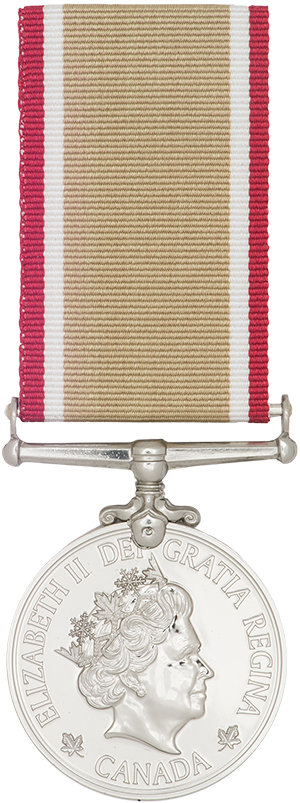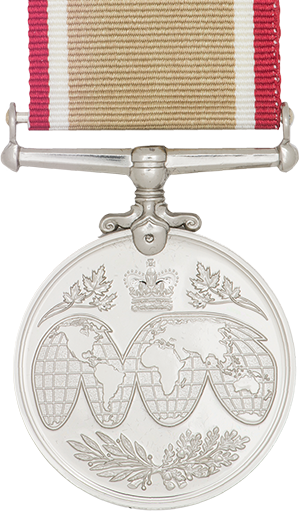Operational Service Medal – South-West Asia (OSM-SWA)
The official description, eligibility, criteria, and history of the Operational Service Medal – South-West Asia (OSM-SWA).


Context
This general service award has been created as a means to recognize in a timelier manner those who serve in or provide support to overseas operations and for which no other medals, such as United Nations or NATO medals, are available. Rather than creating a new honour for each new Canadian Forces (CF) operation as it arises, the Operational Service Medal — with its theatre- or task-specific ribbons — can be awarded in future to honour participation in any operation that meets the criteria.
Eligibility and criteria
The Operational Service Medal (OSM) is awarded to:
- members of the CF;
- members of allied forces serving with the CF;
- members of recognized Canadian police forces and allied police officers working with them; and
- Canadian citizens in the employ or under contract with the Government of Canada, other than members of the CF or sworn police officers;
- who served in a theatre of operations, provided direct support on a full-time basis to operations conducted in such a theatre, or served under dangerous circumstances outside Canada provided the said service is not counted towards another service medal other than the Canadian Peacekeeping Service Medal where applicable.
The OSM is always issued with a ribbon specific to the theatre or type of service being recognized, and each ribbon has its own criteria.
The OSM with SOUTH-WEST ASIA ribbon is awarded to non-DND eligible persons who served the theatre of operations consisting of the political boundaries of Afghanistan, the Persian Gulf, the Gulf of Oman, the Gulf of Aden, the Red Sea, the Suez Canal, and those parts of the Indian Ocean and the Arabian Sea that are west of sixty-eight degrees East longitude and north of five degrees South latitude, as well as the airspace above those areas, or provided direct support to operations conducted in those areas from outside Canada for at least 30 cumulative days between 7 October 2001 and 13 Mar 2014 or for at least 21 cumulative days from 14 March 2014 onwards.
Personnel who have eligible service under the old criteria but did not meet the eligibility criteria, and who also have eligible service under the new eligibility criteria, shall be allowed to combine all the eligible days of service towards the new criteria. Essentially, one has to serve at least one eligible day under the new eligibility to be able to cumulate all past eligible service toward the shorter criteria.
Eligible service may be added to the eligibility list for the ribbon by the Chief of the Defence Staff in consultation with Armed Forces Council and on the recommendation of the Canadian Forces Honours Committee, provided the service in question meets the basic criteria and intent of the medal as described in the regulations.
The only civilians eligible are Members of the Public Service or Canadian civilians under contract with the Government of Canada in the theatre and at the dates indicated. Foreign civilians are not eligible for the OSM.
The only members of allied forces eligible are those who serve in theatre on behalf of Canada. They are usually foreign exchange personnel who deploy with our units or personnel seconded to the CF specifically to serve in our mission. In all cases, they must be on the CFTPO filling a Canadian position and they are usually assigned a CF service number. Foreign personnel working in concert with the CF or reporting to a Canadian superior in an international context are not eligible for Canadian service medals.
Aircrew flying into the theatre accumulate one day of service for the first sortie flown on any day. Additional sorties flown on the same day receive no further credit.
The first and last days in theatre count as full days.
To be eligible to be awarded the Medal, service and direct support must be performed under exceptional circumstances and the person must have been deployed specifically to provide that service or support on a full-time basis to the operations. Only when there is a certain level of risk, threat, hardship, or operational intensity can the Medal be awarded. Any service or support that is comparable in nature to normal duty or that is performed from the relative safety of a country distant from the theatre or area shall be excluded from eligibility.
Technical Assistance Visits, Staff Inspection Visits, and Staff Assistance Visits in theatre will now be considered eligible service towards the OSM.
Certain other types of visits and inspections do not constitute qualifying service. Specifically, visits for the purpose of leadership, familiarization, ceremonial, or morale by civilian or military VIPs and other similar administrative activities are excluded from qualification.
Any person who dies or is evacuated because of injuries or medical reasons directly attributable to service is deemed to have satisfied the time criteria set out above. Any recipient of the Medal who dies or is evacuated because of injuries or medical reasons directly attributable to service shall be credited the entire period the person would have served should the person have completed their tour of duty for the purpose of calculating eligibility towards Rotation Bars.
The Medal and Rotation Bars shall be awarded for honourable service.
For more details, consult the Eligible Service List (accessible only on the Government of Canada network).
Description
The OSM is a silver-coloured circular medal, 36 mm across, bearing on the obverse a contemporary effigy of the Sovereign of Canada, circumscribed with the inscription in capital letters of the Canadian Royal Title and the word "CANADA", separated by small maple leaves. On the reverse of the Medal, from top to bottom, appear the Royal Crown on either side of which are three maple leaves conjoined on one stem, a Goode interrupted homolosine equal-area projection of the globe, and a laurel branch crossed with an oak branch.
The tradition generally followed since the mid-19th century has been to depict who the medal is from on the obverse, what the medal is for on the reverse, and who the medal is granted to on the edge. The effigy of The Sovereign and the Crown represent not only The King as Canada’s Head of State (highlighted by the word CANADA and the maple leaves on both sides of the medal) but also as the FONS HONORIS (the Fount of All Honours). The King is the only person who can create an official honour in Canada and all Canadian Honours are bestowed in His name. The maple leaves represent Canada with those conjoined on one stem on the reverse coming from the Royal Arms of Canada. The globe represents the spectrum of Canada’s involvement and service throughout the world, while the laurel and oak leaves represent honour, strength, and victory.
The Medal is made of cupro-nickel and lacquered to prevent tarnishing. It is manufactured by the Royal Canadian Mint. The Medal is engraved on the edge with the service number, abbreviated rank, initials, and surname of military and police recipients and with the forenames and name of civilian recipients.
A claw at the top of the medal is attached to a straight slotted bar.
The ribbon is 32 mm wide with a central stripe of sand colour (22 mm), on either side of which are stripes of white (2.5 mm) and red (2.5 mm). Red and white are the official colours of Canada as appointed by King George V in 1921, and the sand colour represents the challenge of the South-West Asia theatre of operations.
The rotation bars for the Medal are silver in colour with a raised edge and bear either one or five maple leaves.

Bar(s)
Rotation bars have been created to recognize long periods of service in a theatre.
Recipients of the OSM may be awarded a first Rotation Bar after a total of 210 days of eligible service, including the days taken into account for the award of the original medal, and additional bars are awarded for each subsequent period of 180 days.
One bar bearing five maple leaves is worn in lieu of five bars bearing one maple leaf.
Wearing
The OSM-SWA shall be worn in the sequence prescribed in the Canadian Orders, Decorations and Medals Directive, and in the following manner:
- On the left breast, suspended from the ribbon described above, between the General Service Medal with EXPEDITION ribbon and the Operational Service Medal with SIERRA LEONE ribbon;
- One bar is worn centred on the ribbon;
- If several Rotation Bars have been awarded, they shall be evenly spaced on the ribbon in the order earned, with the first bar earned worn the closest to the Medal; and
- When the undress ribbon is worn, a silver maple leaf shall be worn centred on the ribbon of the Medal to indicate the award of a Rotation Bar, a gold maple leaf shall be worn to indicate the award of a second Rotation Bar, and a red maple leaf shall be worn to indicate the award of a third Rotation Bar. If more than three Rotation Bars have been awarded, those devices shall be worn in combination so as to indicate the total number of Bars awarded.
Post-nominals
The use of a post-nominal is not authorized for this medal.
Historical notes
The OSM was created in Toronto by Her Majesty Queen Elizabeth II on 5 July 2010. The inaugural presentation ceremony took place on 6 December 2010 in the Ballroom of Rideau Hall in Ottawa On this occasion, His Excellency the Right Honourable David Johnston, CC, CMM, COM, CD, Governor General and Commander-in-Chief of Canada, presented the Medal to 50 representative recipients, including five police officers and two civilians. The OSM ribbons were represented as follows at the ceremony: 5 SIERRA LEONE; 20 HAITI; 6 SUDAN; 15 HUMANITAS; and 4 EXPEDITION.
Major Carl Gauthier of the Directorate of Honours & Recognition and Cathy Bursey-Sabourin, Fraser Herald at the Canadian Heraldic Authority at the Chancellery of Honours, Rideau Hall, collaborated to create the design.
As of 31 December 2024, 590 awards have been made.